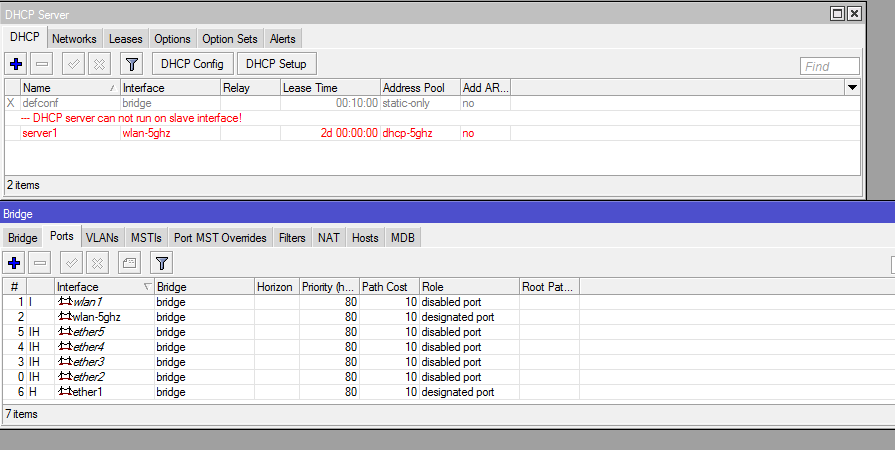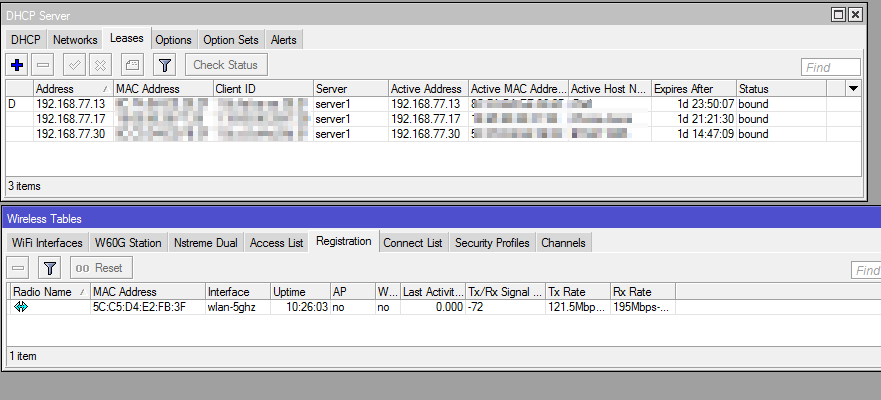Hello, does anyone know why I can’t configure DHCP if it’s assigned to wireless interface? Interface is connected to the bridge.
Strage thing is that sometimes I can commit changes to the dhcp server still. But most of the time it shows “DHCP server cannot run on slave interface”. But at the same time the server iteself works: it assignes IPs and shows active leases. The only strage thing is that leases are assigned not in a consecutive order… For example, the very first client that was connected via DHCP got the address from the very end of the pool - 192.168.77.30. And yes, there are active wireless registrations at the time of screenshots. RoS is v6.42.7. Device is RB AC lite.


It’s what it says, it doesn’t make sense to have DHCP only on one port, when all bridged ports are connected together. DHCP server belongs on the bridge interface itself.
what you expecting, to run dhcp-server on interfaces who is in the bridge? ncncnc
Good point, indeed! One can never understand why such basic things can disappear from one’s mind =)
I wanted to issue one DHCP setting if connected to the 1st wireless interface and a different DHCP setting if connected to a 2nd radio (different gateway, same subnet but non-overlapping ip pools). And still clients from both radios should be in the same LAN segment w/o software routing. Any other ways to achieve that?
This doesn’t make much sense to me. You want to have clients separated but not separated? What do you want to achieve by using separate IP pools from same subnet on different radios?
If the whole exercise is to avoid CPU when communications between clients: it somehow seems that Mikrotik is moving towards software-only bridges so all of the traffic hits CPU one way or another. Besides, all traffic to and from radio is handled by CPU anyway, no HW offload is possible here.
I’ve got two WANs (4G dongles) and I want different clients to connect to a different WAN at their discretion and not statically. By means of swithing access points. Each AP will have to have a DHCP with a different gateway. And yet two clients connecting via different APs shall be in the same LAN segment.
it seems so but it’s still not feasible with the Soho routers like Wireless AC lite that I’m using. I’ve got multicast source in the same LAN segment (where control traffic is via multicast but the media is unicast). If I have multicast source and destination in different birdges then the CPU goes to around 75% when unicast stream begings at rate about 60Mbps. it’s therefore I want everyting in a single LAN segment.
I don’t think it’s doable in the way you imagined to do it. Thing is that there can only be one DHCP server in single L2 domain (there can be more than one but they need to be synchronized one way or another). But you can’t divide your WiFi network to two L2 domains because you want to have single subnet because of broadcast/multicast constrains.
DHCP server on ROS can not be configured to assign IP address from different pools depending on interface which brings in the DHCP request. This might be doable if using RADIUS server, but that might be overkill in your case.
I don’t think it’s doable in the way you imagined to do it. Thing is that there can only be one DHCP server in single L2 domain (there can be more than one but they need to be synchronized one way or another). But you can’t divide your WiFi network to two L2 domains because you want to have single subnet because of broadcast/multicast constrains.
DHCP server on ROS can not be configured to assign IP address from different pools depending on interface which brings in the DHCP request. This might be doable if using RADIUS server, but that might be overkill in your case.
thanks for prompt help anyway! Let me think how can I split the network then…
Did you ever manage to find a solution to this as I have exactly the same requirement.
Same subnet for bonjour and other purposes.
2 x ssid from ubiquiti AP
1 ssid to use one gateway, 1 to use the other.
The only way to achieve this is with a routing mark from different dhcp servers and a split pool